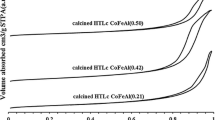Abstract
The stability of heterogeneous catalytic systems is critical for their long-term. Therefore, the thermal degradation behaviors of CuO/ZnO supported on octaphenyl and dodecaphenyl polyhedral oligomeric silsesquioxane and silsesquioxane were investigated. The presence of the metal oxides does not interfere with the degradation mechanisms up to the temperature of 450 °C. After that temperature, the metal oxides accelerate the degradation rate of the supports. Irreversible thermal events, including molecular relaxation and crystal rearrangement, with low transition energy, were observed using differential scanning calorimetry. In all cases, the thermal analysis revealed complex behaviors. The crystal structure of both supports is destroyed in the oxidative atmosphere at 900 °C but partially destroyed in the nitrogen atmosphere. The vibrational frequencies of the residues in the inert and oxidative atmosphere showed after 500 °C the deformation of the Si–O peak due to intercage linkages formation.













Similar content being viewed by others
Data availability
The data that support the findings of this study are available in the Supplementary Information.
References
Argyle MD, Bartholomew CH. Heterogeneous catalyst deactivation and regeneration: a review. Catalysts. 2015;5:145–269.
Trimm DL. Thermal stability of catalyst supports. In: Studies in surface science and catalysis. Amsterdam: Elsevier; 1991. p. 29–51.
Dalai AK, Davis BH. Fischer-tropsch synthesis: a review of water effects on the performances of unsupported and supported Co catalysts. Appl Catal A General. 2008;348:1–15.
Zhang X, Zhang G, Liu W, Yuan F, Wang J, Zhu J, Jiang X, Zhang A, Ding F, Song C, Guo X. Reaction-driven surface reconstruction of ZnAl2O4 boosts the methanol selectivity in CO2 catalytic hydrogenation. Appl Catal B Environ. 2021;284:119700.
Kurtz M, Strunk J, Hinrichsen O, Muhler M, Fink K, Meyer B, Wöll C. Active sites on oxide surfaces: ZnO-catalyzed synthesis of methanol from CO and H2. Angew Chem Int Ed. 2005;44:2790–4.
Rodriguez Herrero Y, Ullah A. Hydrophobic polyhedral oligomeric silsesquioxane support enhanced methanol production from CO2 hydrogenation. ACS Appl Mater Interfaces. 2023;15:14399–414.
Blanco I, Bottino FA, Abate L. Influence of n-alkyl substituents on the thermal behaviour of Polyhedral Oligomeric Silsesquioxanes (POSSs) with different cage’s periphery. Thermochim Acta. 2016;623:50–7.
Laine RM, Roll MF. Polyhedral phenylsilsesquioxanes. Macromolecules. 2011;44:1073–109.
Zhang W, Camino G, Yang R. Polymer/polyhedral oligomeric silsesquioxane (POSS) nanocomposites: an overview of fire retardance. Prog Polym Sci. 2017;67:77–125.
Lichtenhan P. Blanco, POSS-based polymers. Polymers (Basel). 2019;11:1727.
Fina A, Tabuani D, Carniato F, Frache A, Boccaleri E, Camino G. Polyhedral oligomeric silsesquioxanes (POSS) thermal degradation. Thermochim Acta. 2006;440:36–42.
Blanco I, Abate L, Bottino FA, Bottino P, Chiacchio MA. Thermal degradation of differently substituted Cyclopentyl Polyhedral Oligomeric Silsesquioxane (CP-POSS) nanoparticles. J Therm Anal Calorim. 2012;107:1083–91.
Mantz RA, Jones PF, Chaffee KP, Lichtenhan JD, Gilman JW, Ismail IMK, Burmeister MJ. Thermolysis of polyhedral oligomeric silsesquioxane (POSS) macromers and POSS−siloxane copolymers. Chem Mater. 1996;8:1250–9.
Fan H, Yang R. Thermal decomposition of polyhedral oligomeric octaphenyl, octa(nitrophenyl), and octa(aminophenyl) silsesquioxanes. J Therm Anal Calorim. 2014;116:349–57.
Bohmer N, Roussiere T, Kuba M, Schunk SA. Valorisation of glycerol as renewable feedstock: comparison of the exploration of chemical transformation methods aided by high throughput experimentation. Comb Chem High Throughput Screen. 2012;15:123–35.
Montoya Sánchez N, de Klerk A. Oxidative ring-opening of aromatics: Thermochemistry of sodium, potassium and magnesium biphenyl carboxylates. Thermochim Acta. 2016;645:31–42.
Blanco I, Abate L, Bottino FA. Mono substituted octaphenyl POSSs: the effects of substituents on thermal properties and solubility. Thermochim Acta. 2017;655:117–23.
Höhne GWH, Hemminger WF, Flammersheim, H-J. Theoretical fundamentals of differential scanning calorimeters. Differ Scanning Calorim 2003; 31–63.
Zhang D, Yang R, Qin Z, Zhang W. Study on the thermal behaviors of polyhedral oligomeric octaphenylsilsesquioxane (OPS). J Therm Anal Calorim. 2023;148:2345–55.
Siew YK, Sarkar G, Hu X, Hui J, See A, Chua CT. Thermal curing of hydrogen silsesquioxane. J Electrochem Soc. 2000;147:335.
Fu N, Liang X, Li Z, Li Y. Single-atom site catalysts based on high specific surface area supports. Phys Chem Chem Phys. 2022;24:17417–38.
Sun J, Bao X. Textural manipulation of mesoporous materials for hosting of metallic nanocatalysts. Chem A Eur J. 2008;14:7478–88.
Trache D, Thakur VK, Boukherroub R. Cellulose nanocrystals/graphene hybrids—a promising new class of materials for advanced applications. Nanomaterials. 2020;10:1523.
Li M, Wang Y, Gao H, Wang J, Sun B. Thermally stable microstructure and mechanical properties of graphene reinforced aluminum matrix composites at elevated temperature. J Mater Res Technol. 2020;9:13230–8.
Sun Z, Zhang H, Zhao Y, Huang C, Tao R, Liu Z, Wu Z. Thermal-stable carbon nanotube-supported metal nanocatalysts by mesoporous silica coating. Langmuir. 2011;27:6244–51.
Fu W, Li Z, Xu W, Wang Y, Sun Y, Dai Y. Exceptionally thermal-stable Al2O3/TiO2 nanofibers by depressing surface-initiated grain growth as new supports for anti-sintering Pt nanoparticles. Mater Today Nano. 2020;11:100088.
Vidal K, Gómez E, Goitandia AM, Angulo-Ibáñez A, Aranzabe E. The synthesis of a superhydrophobic and thermal stable silica coating via sol-gel process. Coatings. 2019;9:627.
Acknowledgements
Authors gratefully acknowledge the funding support from the Natural Science and Engineering Research Council (NSERC) Canada and Alberta Innovates (AI). Dr. Arno De Klerk and his research group are gratefully acknowledged for the support on TGA and DSC instrumentation. The discussions with Dr. Natalia Montoya are gratefully acknowledged.
Author information
Authors and Affiliations
Contributions
YR: Conceptualization, Investigation, Methodology, Formal analysis, Writing original draft, and Data curation. AU: Supervision, Experimental Discussions, Review and Editing.
Corresponding author
Ethics declarations
Conflict of interest
The authors declare that they have no know competing for financial interests or personal relations that could have appeared to influence the work reported in this paper.
Additional information
Publisher's Note
Springer Nature remains neutral with regard to jurisdictional claims in published maps and institutional affiliations.
Rights and permissions
Springer Nature or its licensor (e.g. a society or other partner) holds exclusive rights to this article under a publishing agreement with the author(s) or other rightsholder(s); author self-archiving of the accepted manuscript version of this article is solely governed by the terms of such publishing agreement and applicable law.
About this article
Cite this article
Rodriguez Herrero, Y., Ullah, A. Thermal stability study of catalyst (CuO/ZnO) supported on phenyl polyhedral oligomeric silsesquioxanes. J Therm Anal Calorim 148, 9875–9891 (2023). https://doi.org/10.1007/s10973-023-12367-y
Received:
Accepted:
Published:
Issue Date:
DOI: https://doi.org/10.1007/s10973-023-12367-y




